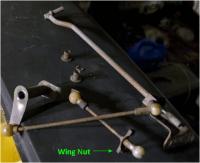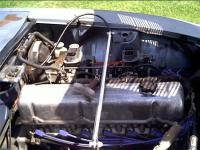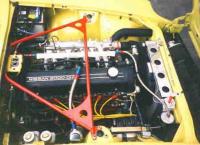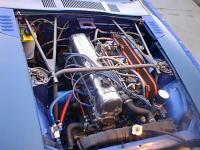Everything posted by 240260280z
-
1970 240z parts for sale
Fuel Rail
-
Loud ticking/knocking noise.
I like happy endings.
-
Newest addition to the garage.
Beautiful car!
-
Oh so THAT's why the rear end is so loose...
The front differential cross member?
-
71' Refresher project starts
Nice reports!
-
OK, I NEED HELP 76 280z Does not start!
Step 1. CheckSpark: (DONE) Step 2. Check Fuel Flow: Disconnect rubber hose at return line near engine fuel filter. (Disconnect where the rubber line goes to the hard line to the tank).Connect rubber line to empty 2 litre soda pop bottle and crank. If fuel flows into bottle then you have flow. If no flow then you may have rubber lines to fuel rail crossed. Step 3. Check Injectors: They should "click" when you crank. Listen to them with a stethoscope or long screw driver. Plugs should also be wet. Report back
- Cam opinions needed - appears to be severely worn (1978 280z)
-
Flywheel slickness
Comet and Ajax are great cleaners, abrasives and degreasers in one.
-
No return spring boss on clutch slave -- OK?
Thanks for the great idea Carl, I just applied it to the Jan '71 I am restoring. In my situation I expanded on your idea. I simply used an engine lift-point head bracket (the longer one with the twist) and connected it to one of the M10 bolts that fastens the transmission to it's front cover plate (next to the slave). Perfect location and fit without having to fabricate. I'll take a picture the next time I am back at it. I guess I could even fab a plastic "strake" to protect the slave from debris and water if I was OCD or racing
- 260z performance improvements
- 260z performance improvements
-
Suspension Refresh - 1970
Looks like you have the ball and socket TC rod kit installed already; so just get a new delrin insert and a rubber bushing for the back. For the end links, I would get the polyurethane type. They do not contribute to roughness of ride however they make your car turn much nicer.
-
Wing nut on accelerator linkage at firewall
What is the purpose of the wing nut on the link through the firewall? How does one set its proper location?
-
Removing Exhaust Port Liners
Those exhaust liners flow fine. Just have a machine shop mill the exhaust valve guides flush with the roof of the runner.
-
the new glyptal?
http://www.cnn.com/2012/05/29/tech/innovation/ketchup-coating-mit/index.html?hpt=hp_t2
- Paint 112
-
Understanding a Weber Side Draft Carburetor Through a Fictional Supposition.
I have been meaning to update this article with tuning guidance following further study on a side draft forum but the data I have so far is inconclusive. I have a set of Webers here that I will experiment with once I break in a resto's engine. One of the problems I found in working with an experimenter on the side draft forum is that the accelerator circuit leaks fuel all the time and it lowers the air:fuel ratio. I speculate that the engine vibration shakes the weights and allows fuel to pass AND there is a vacuum at at accelerator circuit's nozzle at partial throttle as the top of the throttle valve approaches the tail of the main venturi. This leaky accel. circuit makes tuning more difficult. At present, here is what I would do with Weber DCOE's to tune. 1. plug inlet jet/ball valve leak back to accel. circuit at bottom of fuel bowl. 2. set throttle linkage so that valves are covering the first progression hole. 3. remove main jets. 4. experiment at low rpms and tune the idle circuit for idle and low rpm operation 5. install the mains and tune for high rpm and WOT performance 6. install the accelerator circuit jet/ball valve AND add springs to press the weights down OR replace the weights with springs. 7. adjust the accelerator circuit for slow and fast RPM transitions You will have to wait until I get Mikunis. My next project will be ITB's and Mega squirt. FYI here is data from my friend showing the AF ratio and proving a leaking accelerator circuit. (plugged vs non-plugged during slow accelerations (2 min.) to prevent activating the accelerator circuit). This test was repeated 3 times. The red numbers show the change in Air:Fuel Ratio at each corresponding RPM. Here is where I think the vacuum pulls on the accelerator nozzle and causes the greatest fuel leak at cruise:
-
Power force damper @##$$%%
I did ~ 4min with a sand flapper on a drill + valve grinding paste and another 5 min with a brake hone without and without grinding paste... it still does not fit however it is a bit looser for the first 3 or 4mm before it jams. I am getting worried that I may not have a flat face now that I have done so much with a hand tool. This is complete BS how MSA and Powerforce can make and sell ****.
-
Don't buy hood from Black Dragon!!!
BAD DOG is great!
-
Has anyone studied tube/roll bar geometry for strength/rigidity vs. weight
In racing bicycle metal tube design, studies found that tubes can be thinner in the middle of a span to save weight and not sacrifice rigidity and strength in a significant manner, as well, some designs had the main tubes of aluminum and the rear triangle and forks out of chromoly steel to maximize strength. Some early aluminum bikes has all aluminum components but flexed like crazy and broke, later designs used larger diameter tubes to increase strength. I assume the same studies and experiments must be done for automobile tube implementations but it is hard to dig up.
-
Has anyone studied tube/roll bar geometry for strength/rigidity vs. weight
Hi John, I was referring to simply looking at what others are doing via online pictures. The fundamental static engineering rules I refer too are what one learns in an entry level engineering course: loads, torques, etc. in bridges, trusses, towers, etc. The general rules are: straight sub-members and triangle geometry whenever possible. In looking at online photos of other's work, I saw things like a crossbeam through the dash is not one piece but rather complicated into two that were angled where butt-joined, I have seen many "almost triangles", overly complicated dips in door areas, over gusseted, non-gusseted, too many sub-members, not-enough sub-members. I know it all depends on the application, rules, and personal taste however, it got me thinking that there must be an ideal optimized configuration to start from. I just went through this page and it seems to parallel with the core of my question however they show many cat's to skin: http://www.erareplicas.com/misc/stress/deslogic.htm Here is another easier question: "What is the best design for an off-the-shelf engine compartment reinforcement assembly?" Here are some examples, however which gives? 1. Most stiffening 2. Lightest weight 3. Best stiffening to weight trade-off and How does tube diameter, tube wall thickness, internal butting, and mounting point method affect stiffening and weight. The best geometry may be useless if it attaches in a weak manner or in an inappropriate location. A Lightest, no curve in cross member B Big gussets, almost triangle, cross member curved in middle to clear motor,small strut-tower mounting plate C Little gussets, two little triangles, cross member curved near ends to clear motor, large strut-tower mounting plate D No gussets, three triangles,no curve in cross member
-
N47 head
I have seen ~4 heads with cracks in-line with the location where the runners are anchored into the head. My speculation is these cracks result from thermal cycling of the steel and aluminum and their different thermal expansion rates. Or, from overheating (high exhaust gas temp) and their different thermal expansion rates. Nothing you can do about it.
-
Has anyone studied tube/roll bar geometry for strength/rigidity vs. weight
This is done all the time with bike frames, I wonder if anyone has done an actual study for Z cages? The strength/rigidity to weight would be optimized by Tube dia. vs wall thickness vs geometry for a z. I think once an optimized basic design/configuration is found for these two items (strength & weight) then this basic structure can be tweaked for: 1. compliance with rules 2. ergonomics 3. safety I started looking at images of cages online but so many break fundamental engineering rules of "static structures" that I decided to post this question. I guess another option would be to clone BRE and BSR designs but I assume computer modelling has come along way to better their designs? (It certainly has for bikes).
-
Distributor Mount
Just get the crank at TDC and the distributor's rotor should have just swept past #1 CCW ~ 10 degrees (advance).
-
Distributor Mount
I am now looking at this same detail. I think that rather than buying a new mount, one should be able to loosen the oil pump, rotate the distributor spindle, to make any mount work in its sweet spot.










